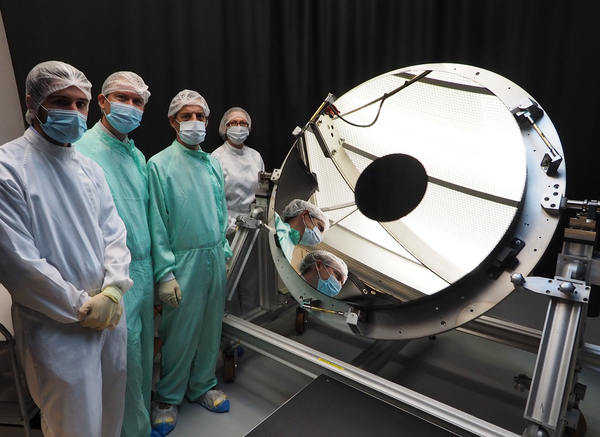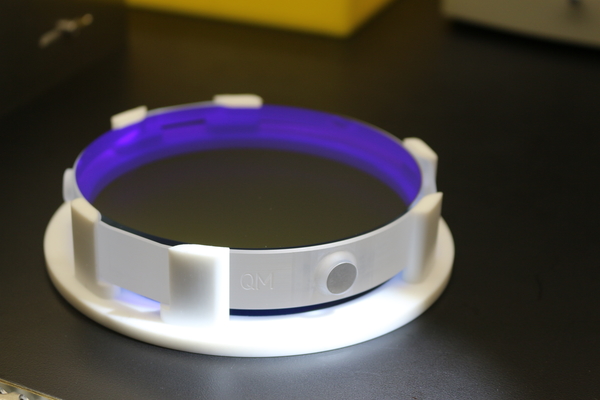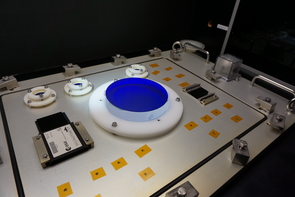Euclid progresses with primary mirror delivery
15 November 2018
In order to observe billions of faint galaxies and investigate the nature of the dark Universe, ESA's pioneering Euclid mission will require state-of-the-art optics. The first optical element to be delivered, the telescope's primary mirror (M1), has arrived at the premises of Airbus Defence & Space in Toulouse. |
| Euclid's primary mirror. Credit: Safran Reosc |
Euclid's optical design is based on a Korsch-type telescope with an aperture diameter of 1.2 m. The telescope has three curved mirrors (including M1) and three flat mirrors, which direct the light to the two instruments on board with the aid of a dichroic filter that separates visible and near-infrared wavelengths.
The Korsch design enables high-quality imaging over a very large field of view, providing a wide-angle camera that is at the same time also extremely sharp. This is no mean feat: in Earthly terms, the telescope would be able to observe a 200-m wide field – equivalent to the area of 8 football pitches – from a distance of 18 km with a resolution of a 1-Euro coin (about 2 cm in diameter).
All of the mirrors are made of the same material: silicon carbide. This same material is also being used for the structure of the telescope in order to minimise the impact of temperature changes on the image quality of the telescope.
"This will enable the entire telescope to 'breathe' smoothly and slowly with the temperature changes, improving the stability of its performance," said Luis Miguel Gaspar Venancio, principal engineer for the Euclid Telescope.
All of the mirrors' surfaces are being manufactured to a degree of perfection unprecedented for any ESA mission observing the cosmos at visible wavelengths. Super-smooth optical surfaces are needed because of the extreme sensitivity of the scientific output to any minute reduction in image quality.
"The science that Euclid will perform requires an extremely accurate and stable telescope," says René Laureijs, Euclid project scientist.
"We want to measure tiny distortions of the shape of galaxies due to the presence of intervening dark matter bending the paths of light from these distant galaxies. By measuring billions of galaxies, we can then map the distribution of the dark matter in the Universe."
The constraining specifications in terms of optical quality are particularly stringent in the case of the M1 mirror, Euclid's largest optical component. The silver-coated, 1.2-m diameter concave parabolic mirror was recently delivered to Airbus from its French manufacturer, Safran Reosc.
The remarkable precision of the primary mirror's shape is such that, if expanded to a diameter of 973 km – equivalent to the north-south extent of France – then the mirror's surface would only deviate from its perfect shape by less than 1.47 cm. Not only its parabolic shape must be extremely accurate, but its surface must be polished to extremely high precision. To continue with the same comparison, if the mirror were expanded to the size of France, any patch of 4 km in diameter would have no 'peaks' higher than the thickness of a human hair.
The other part of Euclid's optics that has already been produced and tested is the dichroic plate, which is made of high quality fused silica glass. Its function is to divide spectrally the incoming light, reflecting visible wavelengths to the Visual Imager (VIS) and near-infrared ones to the Near-infrared Spectrometer and Photometer (NISP).
 |
| Qualification model of Euclid's dichroic filter. Credit: Optics Balzers Jena |
In order to fulfil its role, both of its surfaces are coated with more than 180 thin layers of di-electric materials. High uniformity of these coatings across the 117 mm diameter plate was required.
Although it is the smallest optical component, the dichroic plate is the most critical. Any deformation, or bending, of the dichroic surfaces caused by the deposition of the reflective coating and by temperature changes must be compensated. This is obtained by adjusting the thickness of the coatings on each side in such a way that the deformation of both sides is in opposite directions.
"This means that, when one side of the dichroic is pulled in one direction due to thermo-mechanical effects, then the other side is pulled in the opposite direction – thus counter-balancing the deformation induced by the first side," said Venancio.
 |
| Flight-worthy model of Euclid's dichroic filter. Credit: Optics Balzers Jena |
A flight-worthy model of the dichroic plate was integrated in its final mount and tested by Airbus Defence & Space in October 2017. The tests were performed by Optics Balzers Jena GmbH, the coating manufacturer, for the spectral reflectance and transmittance – how much of the incoming light is reflected and how much is transmitted per wavelength – and the surfaces deformation measurement at cold temperatures will be performed by AMOS, the dichroic glass polisher. Another flight-worthy model of the dichroic plate will be delivered to Airbus by the end of November 2018.
The manufacturing of the other five mirrors is ongoing and all of them are expected to be delivered to Airbus Defence & Space between the end of 2018 and the beginning of 2019. During this production phase, the shape of each mirror is being measured, and the spectral reflectance of two of the flat mirrors is also being sampled.
Tests of the integrated telescope will follow in 2019, once all of the optics have been mounted in the telescope structure.
Meanwhile, the team has completed the Critical Design Review (CDR) for all the units and subsystems on the satellite. These are formal project milestones to certify that the design is supported by adequate analysis and tests, authorising the manufacturing and assembly of the flight hardware. The spacecraft CDR was successfully held earlier this year, and the CDR at mission level, encompassing all mission elements – instruments, spacecraft, science and operational ground segment – is currently ongoing and will be completed at the end of November.
"The delivery of the flight model of the primary mirror is a very important milestone in the project development," says Giuseppe Racca, Euclid project manager.
"In order to avoid delays, the flight models of many elements, like the primary mirror, have already been built, and we are now looking forward to the mission critical design review as a final confirmation that the Euclid design is sound in all of its components and can provide the required scientific performance."
Notes for editors
Euclid is an ESA medium class astronomy and astrophysics space mission. ESA selected Thales Alenia Space as prime contractor for the construction of the satellite and its Service Module, with Airbus Defence and Space chosen to develop the Payload Module, including the telescope.
The Euclid Consortium is a collaboration of nationally funded institutes responsible for the scientific mission, including the scientific instruments and data processing.
For further information please contact:
Giuseppe Racca
Euclid Project Manager
Directorate of Science
European Space Agency
Email: giuseppe.racca![]() esa.int
esa.int
René Laureijs
Euclid Project Scientist
Directorate of Science
European Space Agency
Email: rene.laureijs![]() esa.int
esa.int



